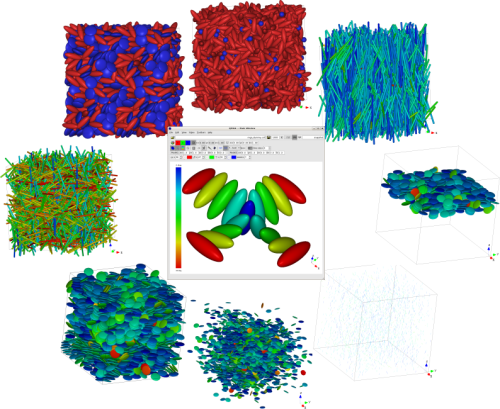

|
Coarse-grained modeling of molecular fluids is often based on non-spherical convex rigid bodies like ellipsoids or spherocylinders representing rodlike or platelike molecules or groups of atoms, with site-site interaction potentials depending both on the distance among the particles and the relative orientation. In this category of potentials, the Gay-Berne family has been studied most extensively. However, conventional molecular graphics programs are not designed to visualize such objects. Usually the basic units are atoms displayed as spheres, or as vertices in a graph. Atomic aggregates can be highlighted through an increasing amount of stylized representations, e.g., Richardson ribbon diagrams for the secondary structure of a protein, Connolly molecular surfaces, density maps, etc., but ellipsoids and spherocylinders are generally missing, especially as elementary simulation units. We fill this gap providing and discussing a customized OpenGL-based program for the interactive, rendered representation of large ensembles of convex bodies, useful especially in liquid crystal research. We pay particular attention to the performance issues for typical system sizes in this feld. The code is distributed as open source. |

|
| The mixture and spherocylinder systems were kindly provided by David Cheung and Paul O'Brien, Molecular Simulation Group (Prof. Michael P. Allen), Department of Physics, University of Warwick, UK. |
Program features:
Program download and online manual. Reference (please cite when using QMGA for a scientific publication):
Adrian T. Gabriel, Timm Meyer, Guido Germano, "Molecular graphics of convex body fluids", J. Chem. Theory Comput. 4, 468-476 (2008), DOI 10.1021/ct700192z, free download by courtesy of ACS, corrections.
See also the conference poster (29 MB) shown at the Rhein-Main Modelling Meeting in Mainz on 15 June 2007, at the Materialforschungstag Mittelhessen in Rauischolzhausen on 6 July 2007, at the CCP2007 - Conference on Computational Physics in Brussels on 5-8 September 2007, and at the NIC-Symposium 2008 in Jülich on 20-22 February 2008.
Send feedback and questions to qmga users.sourceforge.net.
users.sourceforge.net.
Main developers: Adrian Gabriel and Guido Germano (Department of Computer Science, University College London, UK).
Acknowledgements:
Please use the button below to send donations to the PayPal account of the main developer, with 5% going to SourceForge.